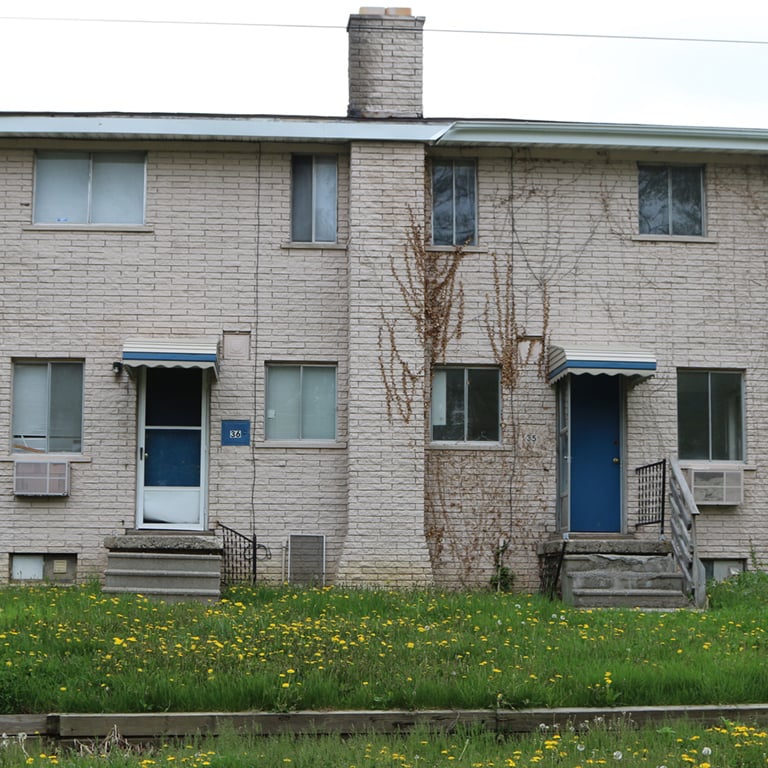

Where Americans live can have a considerable impact on their quality of life. In some U.S. cities, everyday comfort and happiness is much harder to attain than in others.
Quality of life is subjective, and difficult to measure. Still, there is a wide range of quantifiable factors that can impact quality of life in a given area. Affordability, safety, job market strength, quality of education, infrastructure, average commute times, air quality, and the presence of cultural attractions are just a few examples of factors that can influence overall quality of life.
24/7 Wall St. created an index with measures in eight categories — crime, economy, education, environment, health, housing, infrastructure, and leisure — to identify the 50 worst cities to live in. Not confined to a single region, the worst cities span the country from the South to the Midwest and from New England to the Pacific coast.
Correction: In a previous version of this piece, due to a data processing error, the Las Vegas crime rate was reported as 2,136 per 100,000 population. In fact, the metro area’s crime rate is 849.2 per 100,000 population. As a result, Las Vegas should not have been included as one of the worst cities to live in. Our list has changed order and a new metro area, Fort Smith, Arkansas has been added.
Click here to see the worst cities to live in.
Click here to see our detailed findings.
Click here to see our methodology.
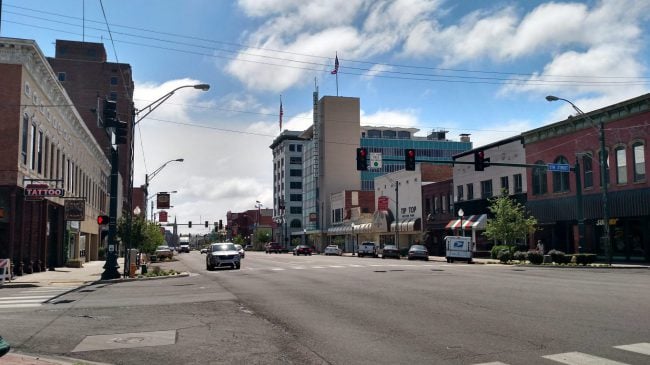
50. Fort Smith, Arkansas
> Population: 88,122
> Median home value: $115,400
> Poverty rate: 21.6%
> Pct. with at least a bachelor’s degree: 20.0%
By a number of measures assessing economic opportunity, education, crime, and public health, Fort Smith is one of the worst cities to live in. Just 20.0% of adults in the city have a bachelor’s degree, far less than the national college attainment rate of 31.3% and the smallest share of any major city in Arkansas. Low educational attainment can limit economic growth in an area and curb the earning potential of its residents. The typical Fort Smith household earns just $38,051 a year, far less than the national median income of $57,617.
Fort Smith also has the highest crime rate of any city in Arkansas other than Little Rock and one of the highest in the United States. There were 808 violent crimes reported in 2016 per 100,000 city residents, far more than the state violent crime rate of 551 incidents per 100,000 people and the national rate of 386 per 100,000.
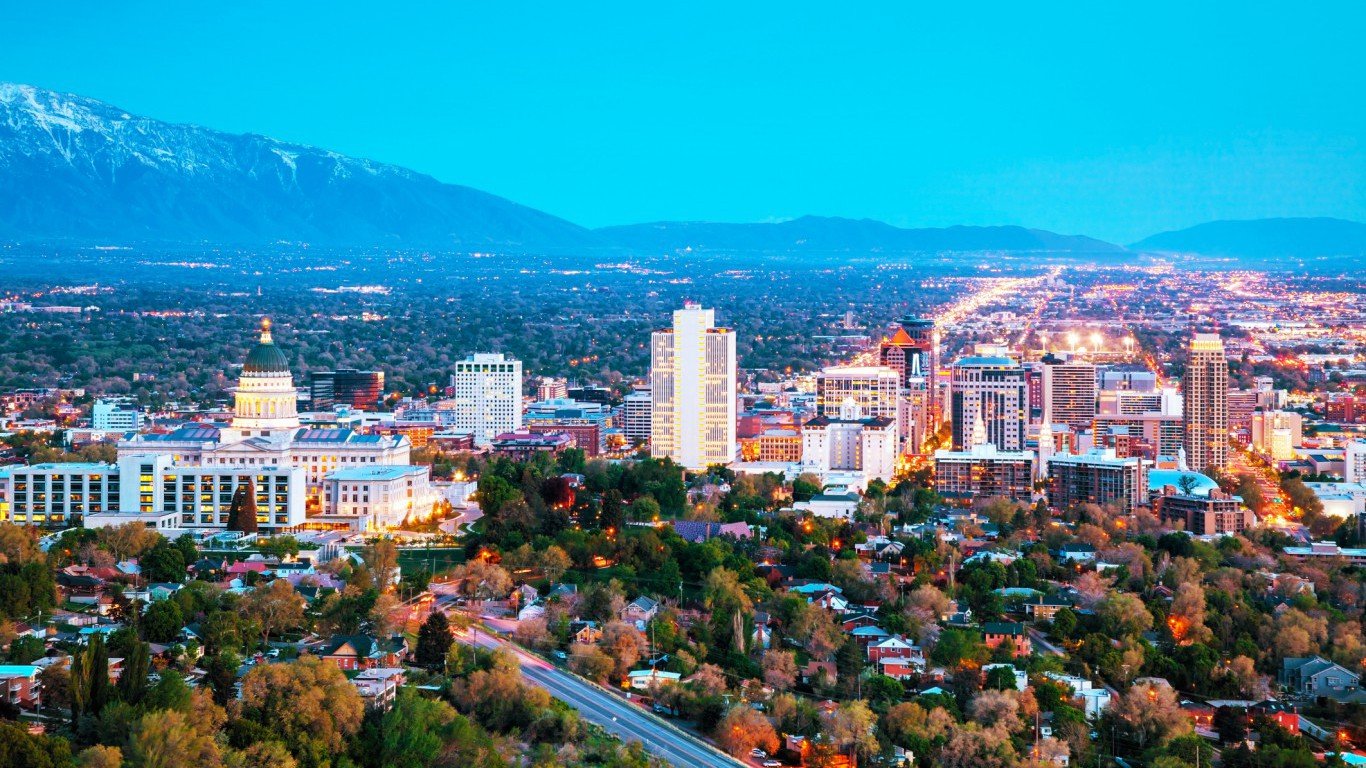
49. Salt Lake City, Utah
> Population: 193,776
> Median home value: $285,100
> Poverty rate: 16.1%
> Pct. with at least a bachelor’s degree: 45.6%
One factor detracting from quality of life in Salt Lake City is the area’s high violent crime rate. Some 937 violent crimes were reported in 2016 per 100,000 city residents, more than twice the national violent crime rate of 386 incidents per 100,000 Americans and nearly four times the state rate of 243 per 100,000 Utah residents. Housing prices in Salt Lake City also have been rising fast in recent years and have outpaced the area’s income growth, making housing unaffordable for many low-income residents.
Despite the high violent crime rate, Salt Lake City has experienced substantial economic growth in the last several years. The number of jobs in the city rose 5.1% from 2014 to 2016, a faster pace than the nation as a whole.
[in-text-ad]
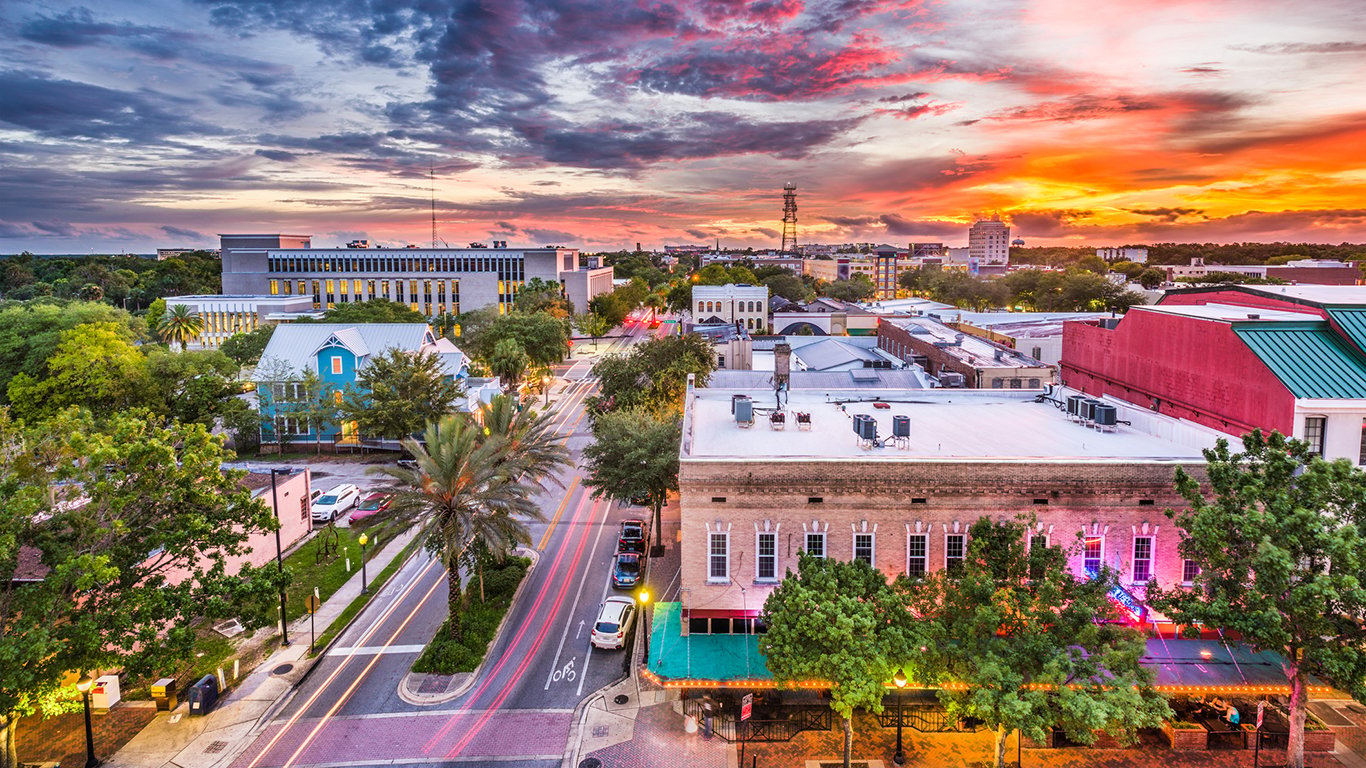
48. Gainesville, Florida
> Population: 131,593
> Median home value: $154,600
> Poverty rate: 33.4%
> Pct. with at least a bachelor’s degree: 42.7%
Gainesville is the home of the University of Florida, one of the top 50 national universities as ranked by U.S. News & World Report and the country’s fifth largest university by undergraduate enrollment. While the presence of a large research university likely has added depth to the area’s talent pool — some 41.7% of Gainesville adults have a bachelor’s degree compared to 31.3% of adults nationwide — quality of life in the city is poor overall.
The typical Gainesville household earns just $32,968 a year, roughly $25,000 less than the national median household income. Some 33.4% of city residents live in poverty, more than twice the U.S. poverty rate of 14.0% and the seventh highest rate of any major U.S. city.
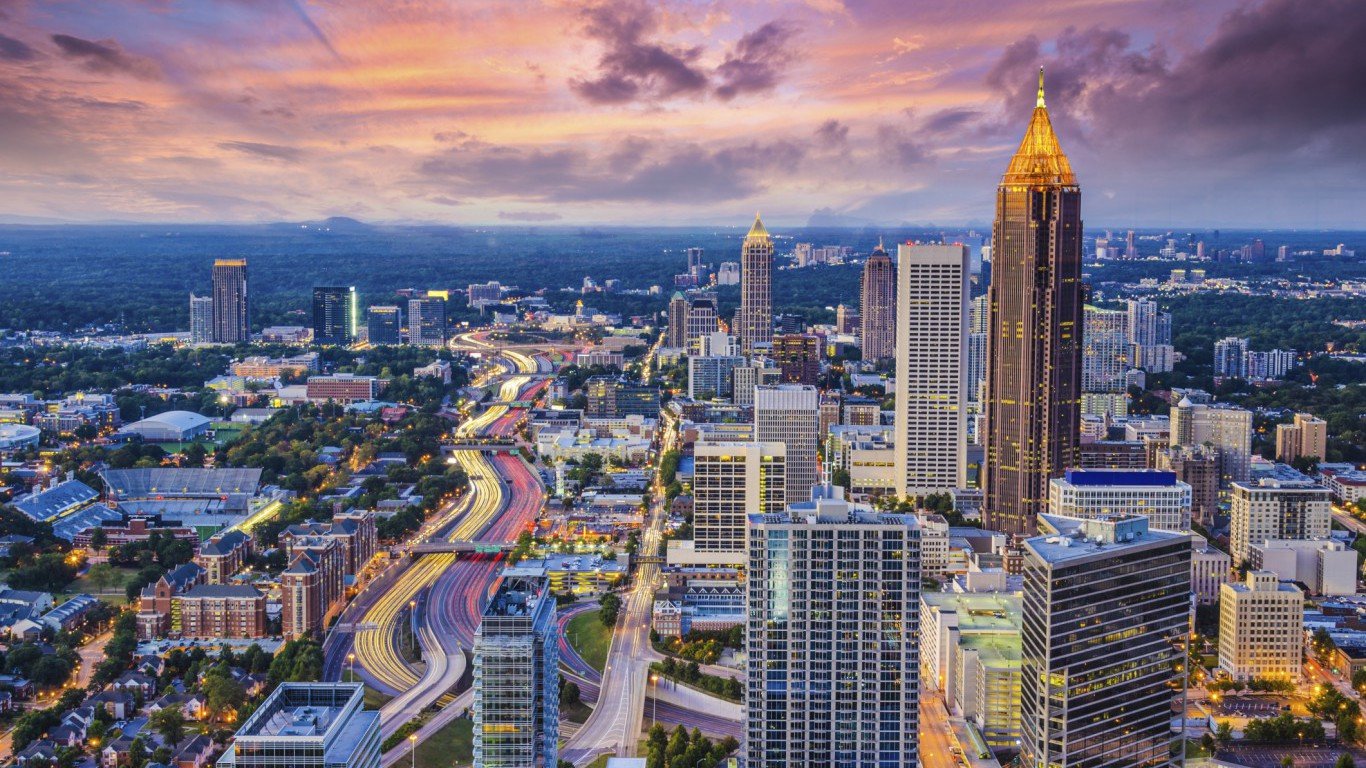
47. Atlanta, Georgia
> Population: 472,506
> Median home value: $262,600
> Poverty rate: 22.4%
> Pct. with at least a bachelor’s degree: 50.5%
While Atlanta has experienced substantial economic and population growth in recent years, the city’s high violent crime rate continues to hinder the area’s quality of life. There were 1,084 violent crimes reported in 2016 per 100,000 Atlanta residents, nearly three times the national violent crime rate of 386 incidents per 100,000 Americans.
Another factor detracting from quality of life in Atlanta is the city’s poor air quality. According to real estate data provider ATTOM Data Solutions, air quality in Atlanta and the surrounding Fulton County is considered non-hazardous just 89.5% of the year, one of the smallest shares of any major city. Air pollution in Atlanta may be partially exacerbated by the area’s record-setting heat in recent years. The temperature in Atlanta exceeded 85 degrees fahrenheit a total of 136 days in 2016, the city’s hottest year on record.

46. Tacoma, Washington
> Population: 211,304
> Median home value: $239,100
> Poverty rate: 16.3%
> Pct. with at least a bachelor’s degree: 27.7%
While Tacoma has experienced substantial economic growth in recent years — the number of employed workers in the city rose by 6.1% from 2014 to 2016, compared to a 3.5% growth nationwide — the area still struggles with high unemployment and violent crime. Some 6.6% of the Tacoma workforce is currently unemployed, a far higher jobless rate than the 4.9% national rate.
Although crime has declined in many of the more dangerous neighborhoods in the city over the last several decades, Tacoma’s violent crime rate remains the highest of any city in the state. There were 947 violent crimes reported in 2016 per 100,000 Tacoma residents, far more than the state violent crime rate of 302 incidents per 100,000 Washington residents and the national rate of 386 per 100,000.
[in-text-ad-2]
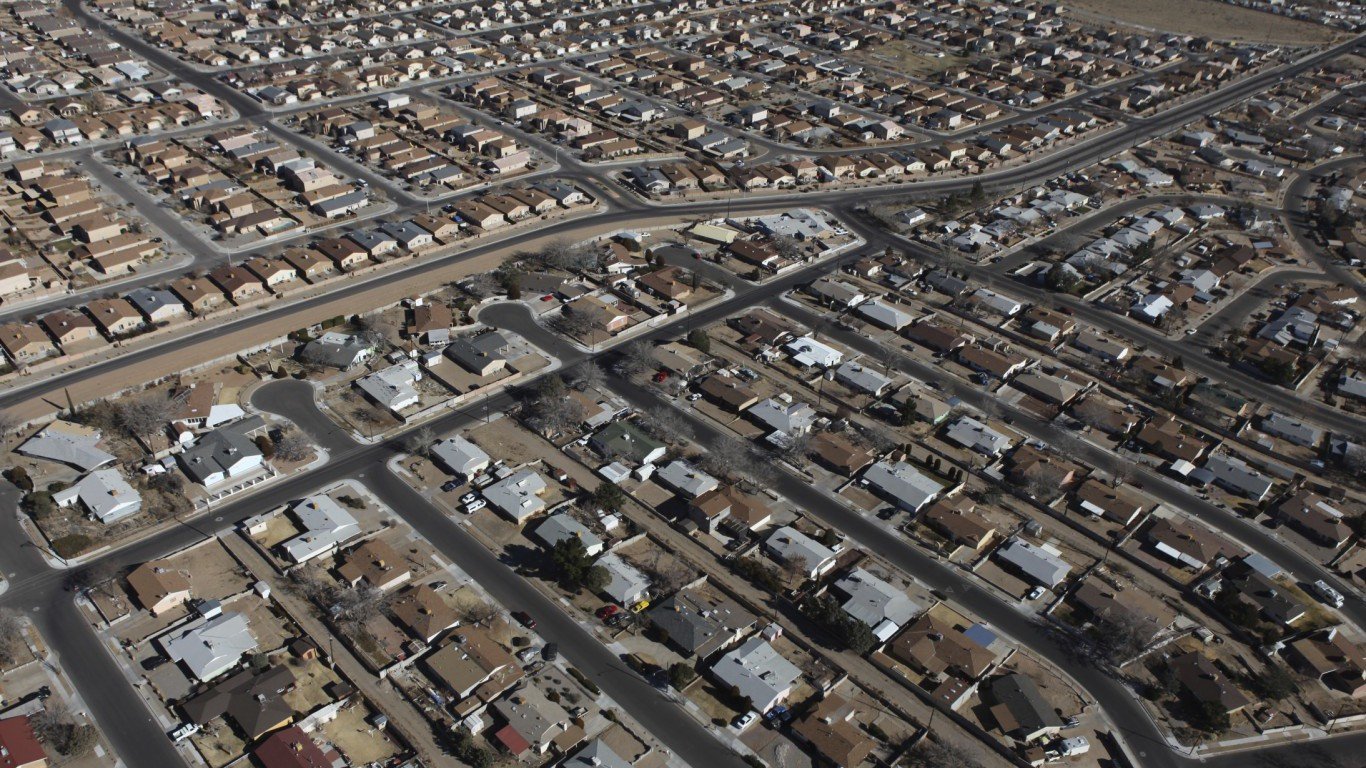
45. Albuquerque, New Mexico
> Population: 559,270
> Median home value: $191,600
> Poverty rate: 17.1%
> Pct. with at least a bachelor’s degree: 35.0%
While cheap land and low taxes have spurred rapid development in much of the area
surrounding Albuquerque, the city’s population growth has been relatively limited in recent years. Albuquerque’s population growth rate of just 1.2% from 2011 to 2016 is less than one-third the national population growth rate of 3.7% over that time. Similarly, the city’s employment growth rate of just 2.4% from 2014 to 2016 was slower growth than in a majority of large U.S. cities over the same period. Some 5.8% of Albuquerque’s workforce is unemployed, a higher jobless rate than the 4.9% national rate.
Albuquerque also struggles with one of the highest violent crime rates in the country. There were 1,117 violent crimes reported in 2016 per 100,000 city residents, the most of any major city in New Mexico and nearly three times the national rate of 386 incidents per 100,000 Americans.

44. Jackson, Mississippi
> Population: 169,141
> Median home value: $88,500
> Poverty rate: 22.0%
> Pct. with at least a bachelor’s degree: 28.6%
By a number of metrics assessing economic opportunity, education, public safety, and infrastructure, Jackson is one of the worst cities to live in in the country. The typical Jackson household earns just $39,742 a year, far less than the national median household income of $57,617. Even adjusted for the area’s low cost of living — goods and services cost 13.9% less in Jackson and the surrounding Hinds County than they do nationwide — incomes in Jackson are still far below the U.S. median. Jackson is also one of the more dangerous Southern cities. There were 856 violent crimes reported per 100,000 residents in 2016, more than twice the national violent crime rate.
Like many areas with low incomes and high violent crime, Jackson has been losing residents. While the U.S. population grew 3.7% between 2011 and 2016, the number of Jackson residents declined by the same amount — the largest population decline in Mississippi and the 14th largest decrease of any major city in the country.
[in-text-ad]
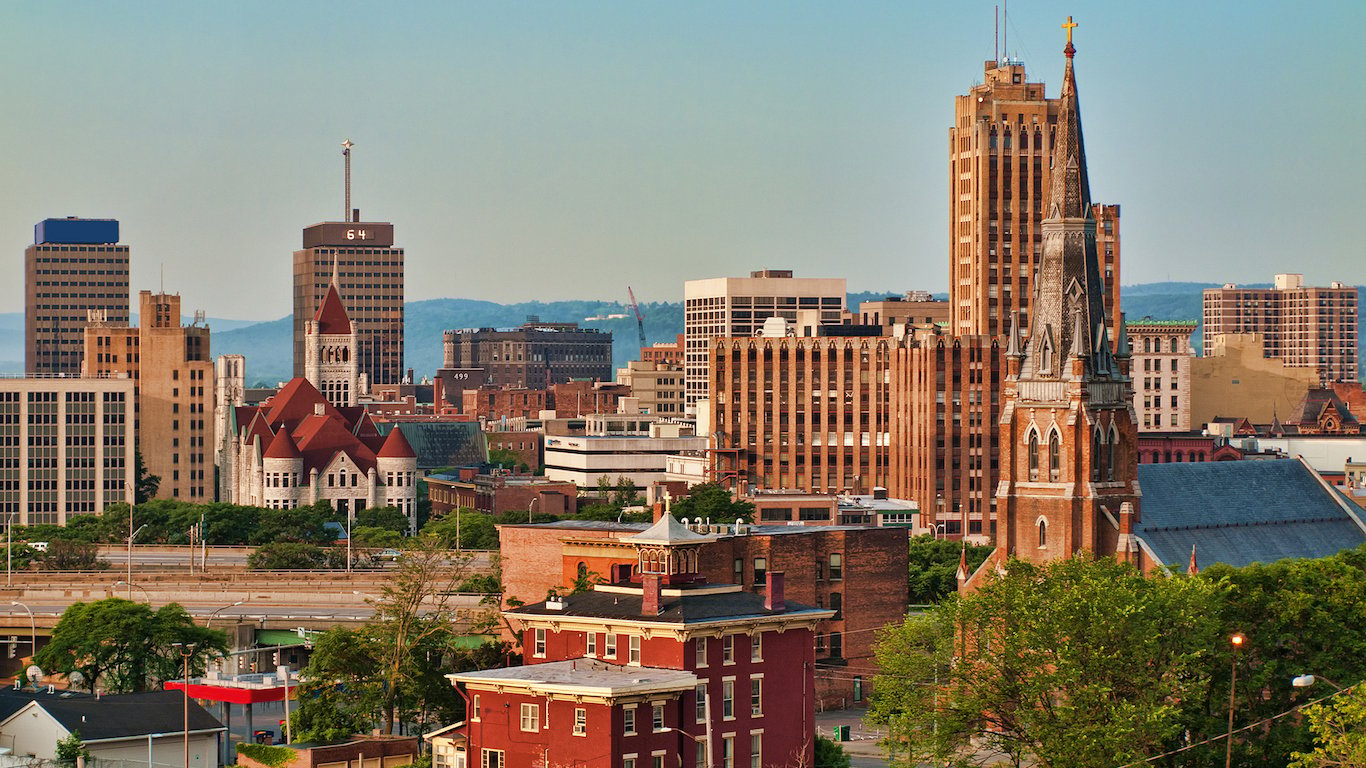
43. Syracuse, New York
> Population: 143,378
> Median home value: $92,900
> Poverty rate: 32.1%
> Pct. with at least a bachelor’s degree: 27.6%
Syracuse is one of two upstate New York cities to rank among the worst cities to live in nationwide. A third, Rochester, nearly made the list as well. A relatively poor city, the typical household in Syracuse earns $33,695 a year, only slightly more than half the median income of $62,909 statewide. Additionally, 32.1% of city residents live below the poverty line, well more than double the state poverty rate of 14.7%.
As is often the case in cities with similarly negative economic indicators, Syracuse is losing residents. In the last five years, the city’s population declined by 1.2%, even as the U.S. population climbed by 3.7%.
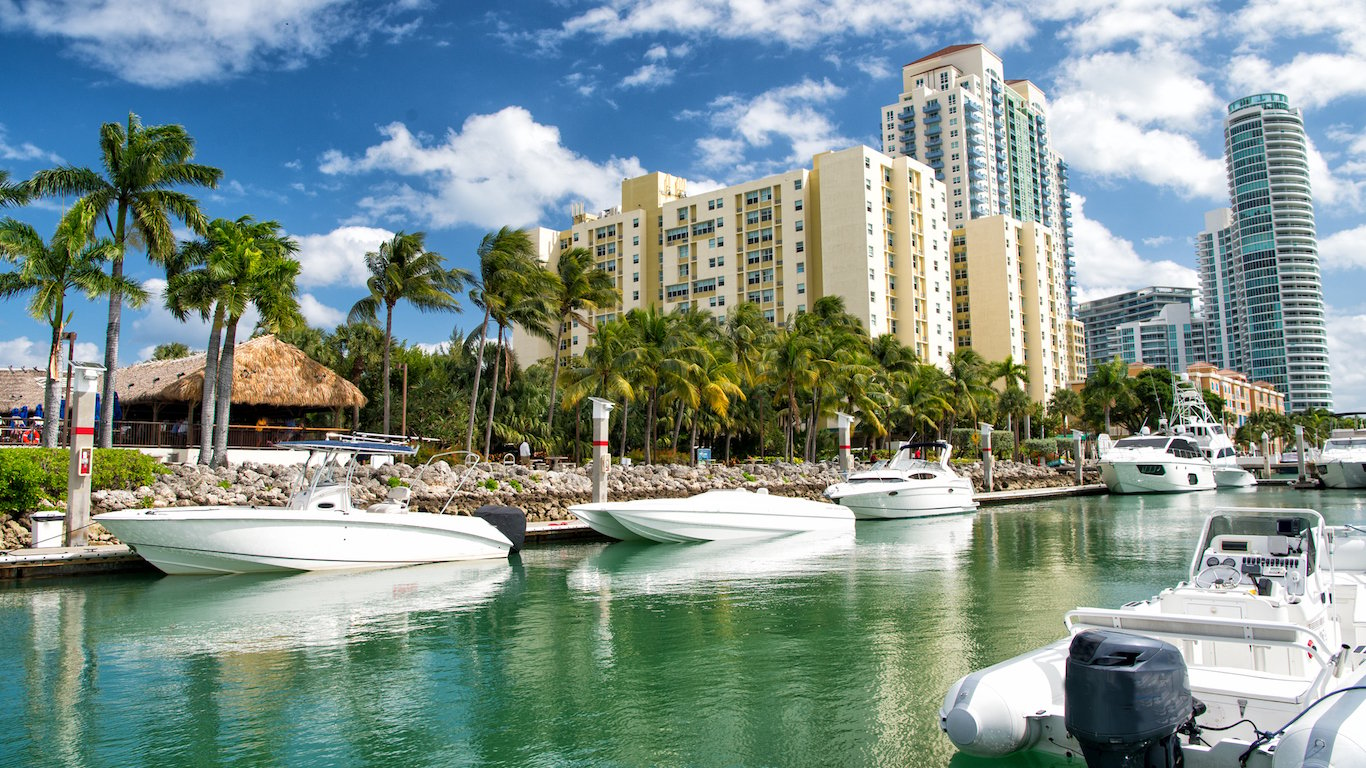
42. Miami, Florida
> Population: 453,584
> Median home value: $277,700
> Poverty rate: 24.9%
> Pct. with at least a bachelor’s degree: 26.6%
Miami is one of the most expensive cities in the country. Goods and services in Miami-Dade County are about 15% more expensive than they are on average nationwide. Housing is particularly expensive. The typical home in Miami is worth $277,700 compared to the median home value of $205,000 nationwide. Despite this, the typical household in the Miami area earns $34,901 a year, well below the median income of $57,617 nationwide.
The city is also relatively dangerous. Violent crime is about twice as common in Miami as it is nationwide as there were 879 violent crimes for every 100,000 people in 2016 compared to 386 per 100,000 nationwide.
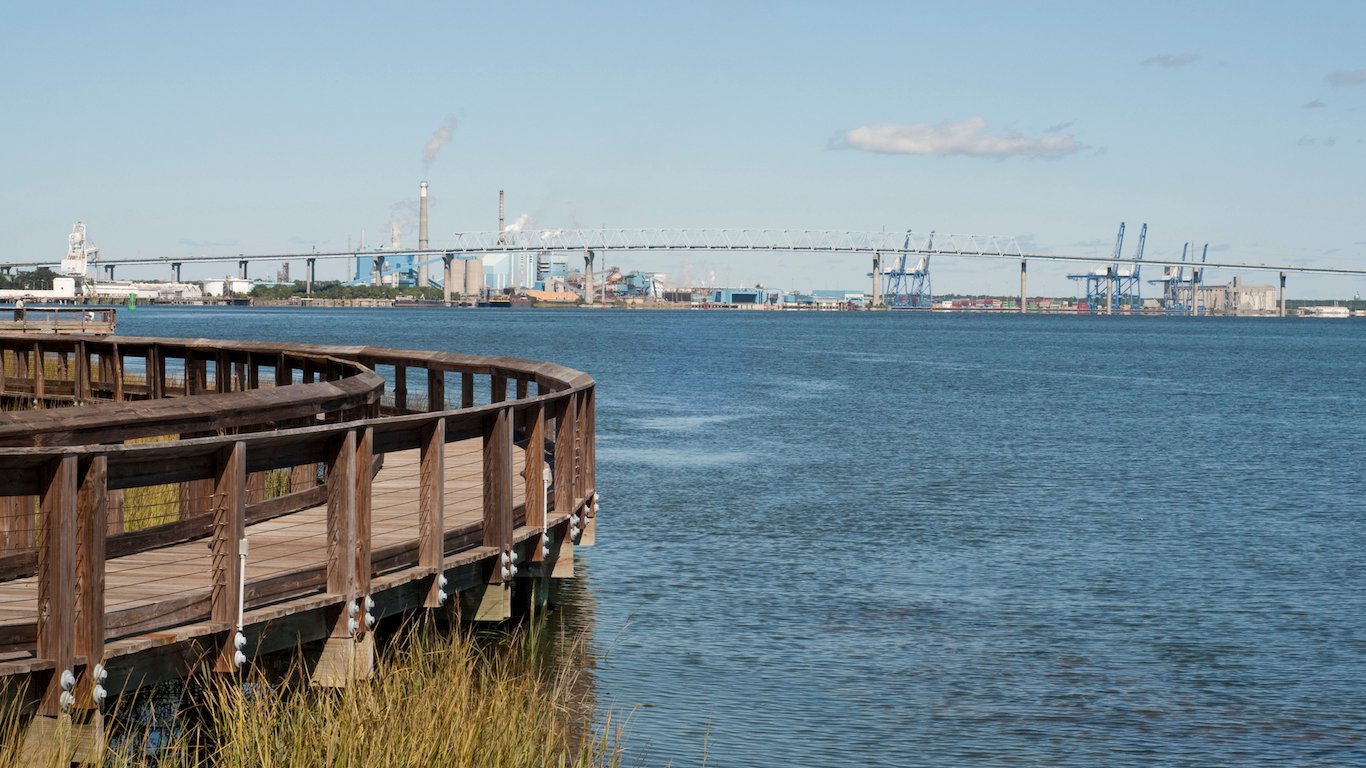
41. North Charleston, South Carolina
> Population: 112,147
> Median home value: $152,000
> Poverty rate: 25.8%
> Pct. with at least a bachelor’s degree: 22.1%
More than one in every four North Charleston residents live in poverty, compared to 15.3% of South Carolinians and 14.0% of Americans. Poorer cities are often relatively dangerous, and North Charleston is no exception. There were 885 violent crimes in North Charleston for every 100,000 residents in 2016, compared to state’s violent crime rate of 502 per 100,000 and the nationwide rate of 386 per 100,000.
While many cities on this list are losing residents, North Charleston is growing rapidly. In the past decade, the city’s population expanded by 34.4%, more than all but a dozen other U.S. cities over the same period.
[in-text-ad-2]
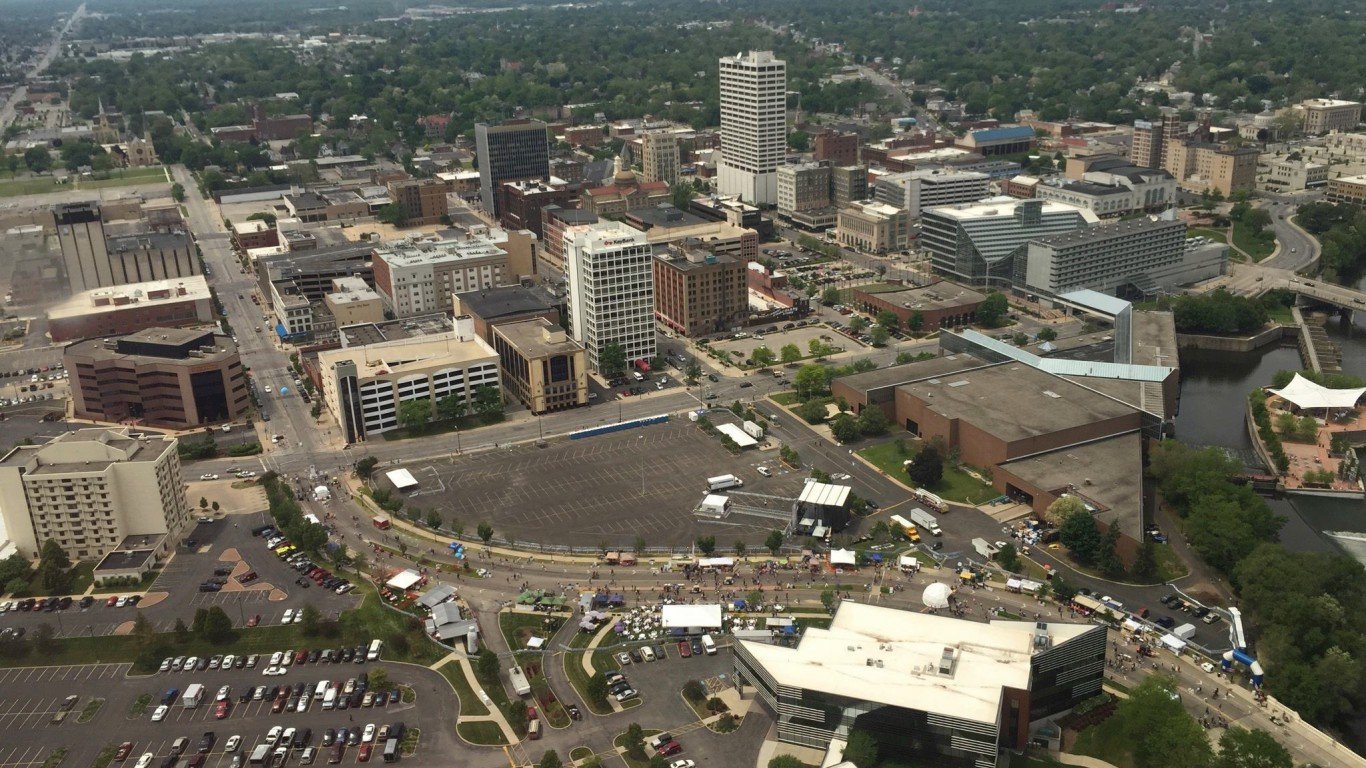
40. South Bend, Indiana
> Population: 102,442
> Median home value: $77,400
> Poverty rate: 24.7%
> Pct. with at least a bachelor’s degree: 24.1%
South Bend, Indiana is one of the most dangerous cities in the United States. There were 1,012 violent crimes in South Bend for every 100,000 residents in 2016, more than double both the state and national violent crime rates of 405 incidents and 386 incidents per 100,000 people, respectively. As is often the case in high crime areas, property values in South Bend are depressed. The typical home in the city is worth just $77,400, less than half the national median home value of $205,000.
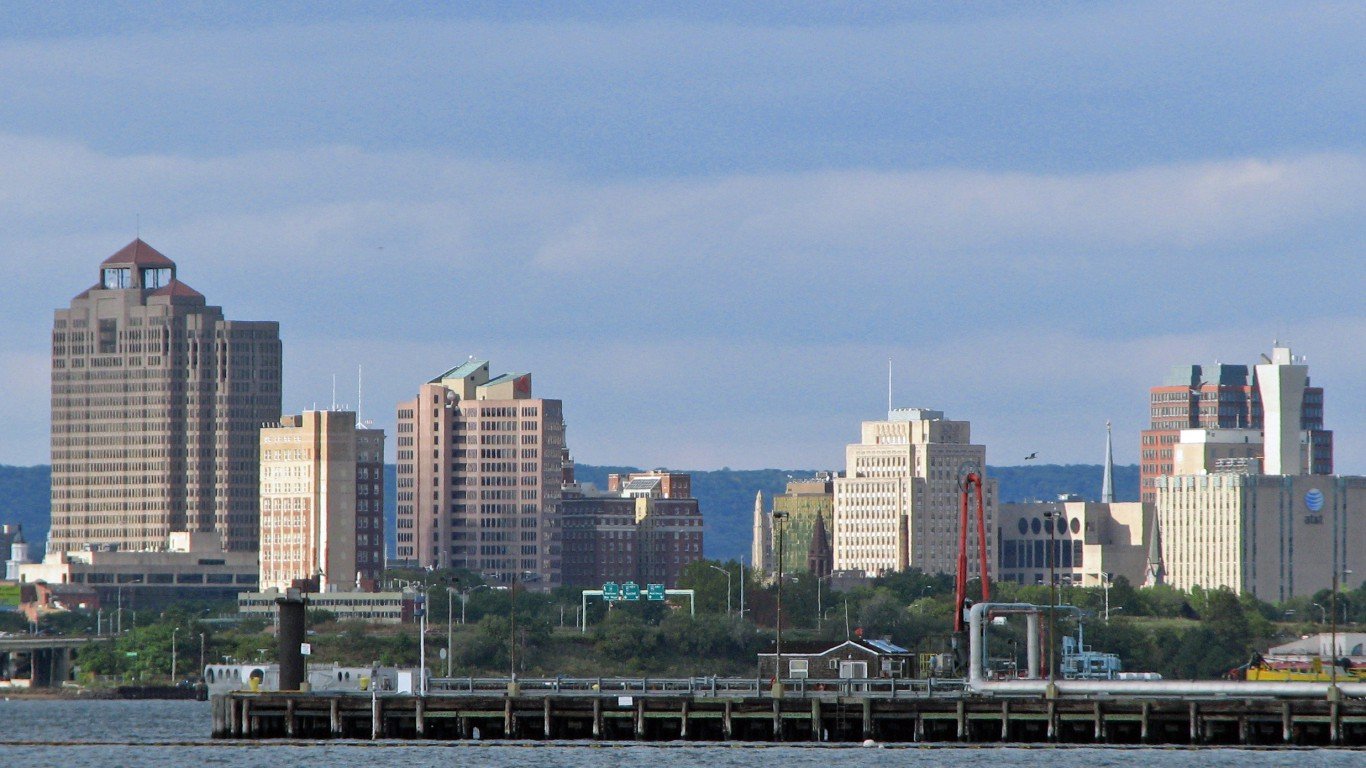
39. New Haven, Connecticut
> Population: 129,939
> Median home value: $191,000
> Poverty rate: 24.5%
> Pct. with at least a bachelor’s degree: 32.4%
New Haven is one of two Connecticut cities to rank among the worst cities to live in nationwide. The city’s 6.6% unemployment rate is higher than both the state jobless rate of 5.1% and the national rate of 4.9%. The weak job market likely only increases financial hardship for some city residents as it is not a particularly inexpensive place to live. Goods and services in New Haven County are about 16.5% more expensive than they are on average nationwide.
New Haven is not an especially safe city. There were 938 violent crimes for every 100,000 city residents in 2016, more than double the national violent crime rate of 386 per 100,000.
[in-text-ad]
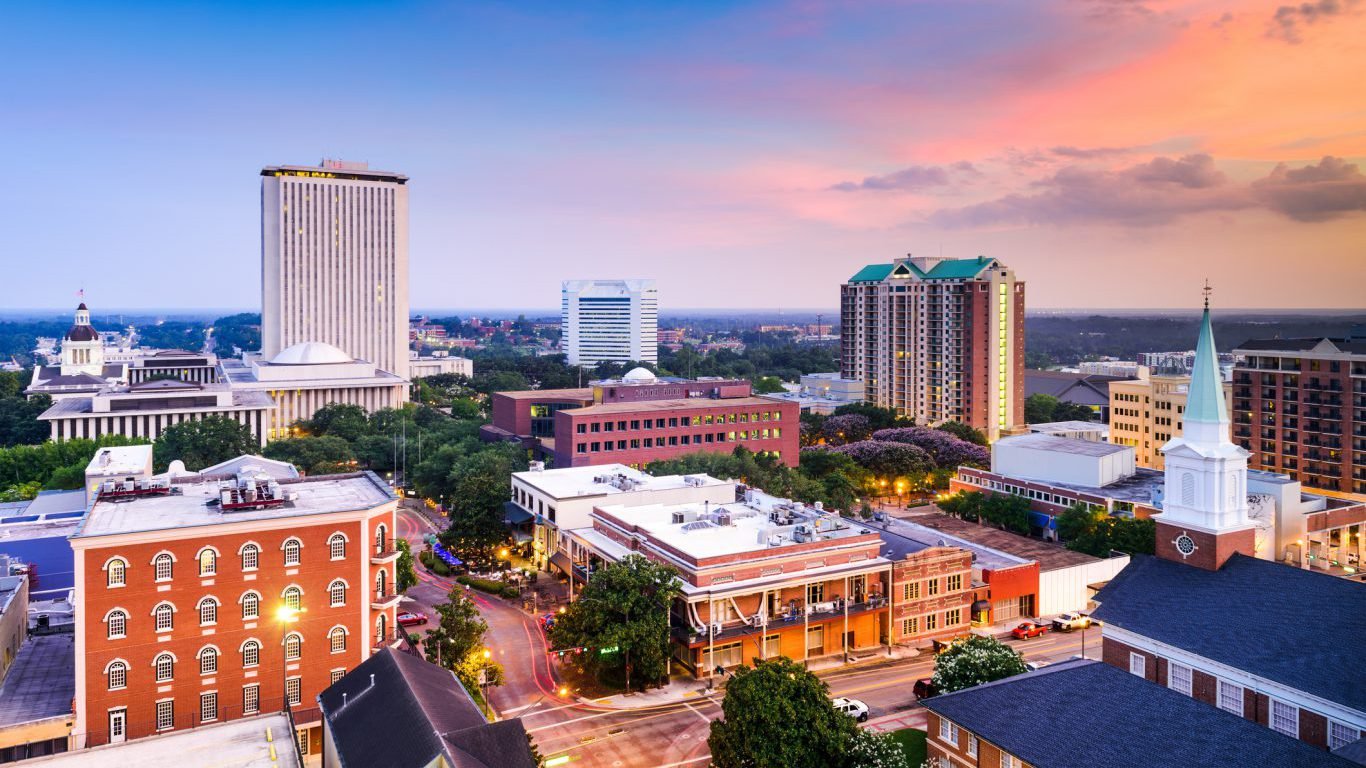
38. Tallahassee, Florida
> Population: 190,895
> Median home value: $196,700
> Poverty rate: 26.1%
> Pct. with at least a bachelor’s degree: 49.6%
Tallahassee is one of six cities in the Sunshine State to rank among the least liveable in the country. As is the case with most other Florida cities on this list, Tallahassee has a relatively high poverty rate. More than one in every four city residents live below the poverty line compared to 14% of Americans nationwide. Additionally, both property and violent crimes are more than twice as common in Tallahassee than they are nationwide.
Unlike most cities on this list, Tallahassee has a large college-educated population. About half of all adults in the city have a bachelor’s degree or higher. In comparison, fewer than one in three adults nationwide have similar educational attainment.
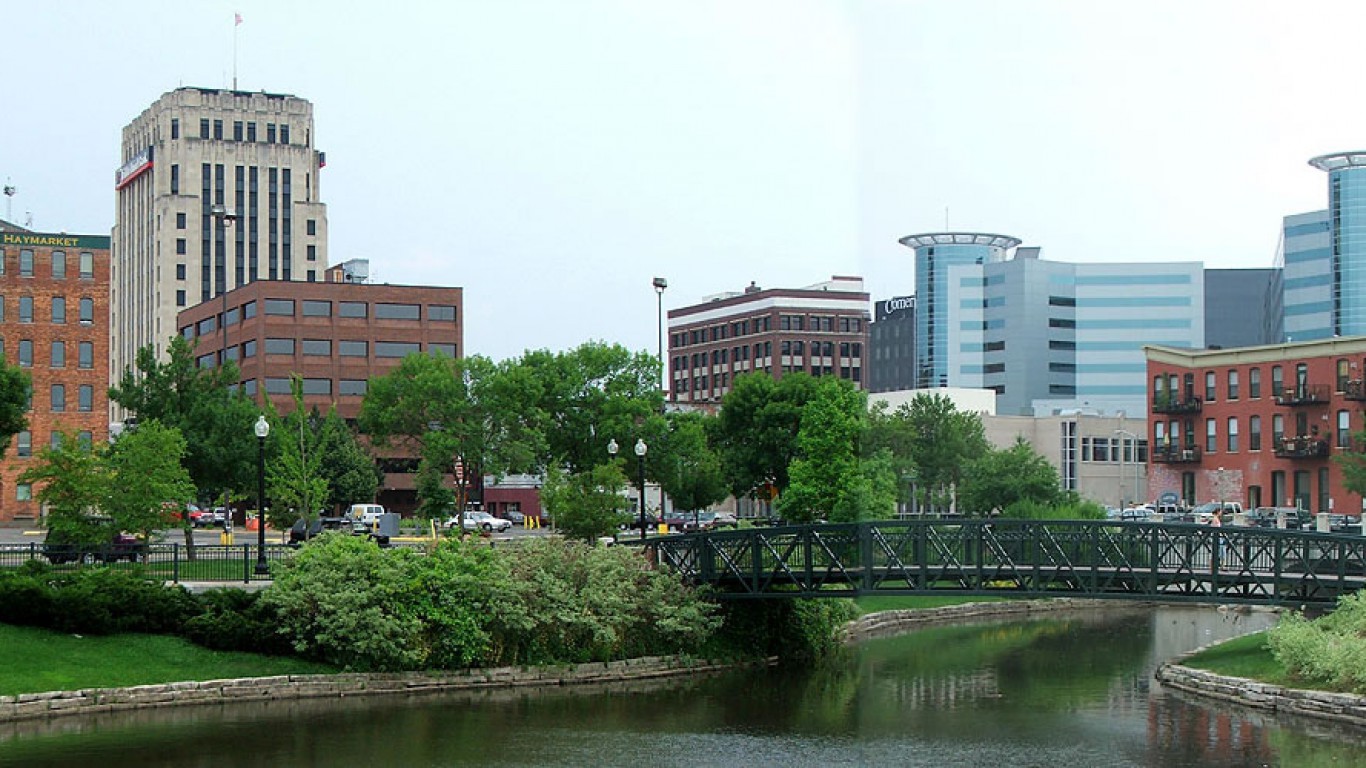
37. Kalamazoo, Michigan
> Population: 75,988
> Median home value: $98,000
> Poverty rate: 30.9%
> Pct. with at least a bachelor’s degree: 31.3%
Air quality in Kalamazoo is nearly the worst of any U.S. city. The city’s air is considered hazardous for about 15% of days in a given year, a far larger share than the 6% average nationwide. The city is also among the most dangerous nationwide. There were 1,217 violent crimes in 2016 for every 100,000 residents, more than triple the U.S. violent crime rate of 386 per 100,000.
As is often the case among cities on this list, Kalamazoo is poor. Over 30% of the population lives in poverty, more than double the U.S. poverty rate of 14%.
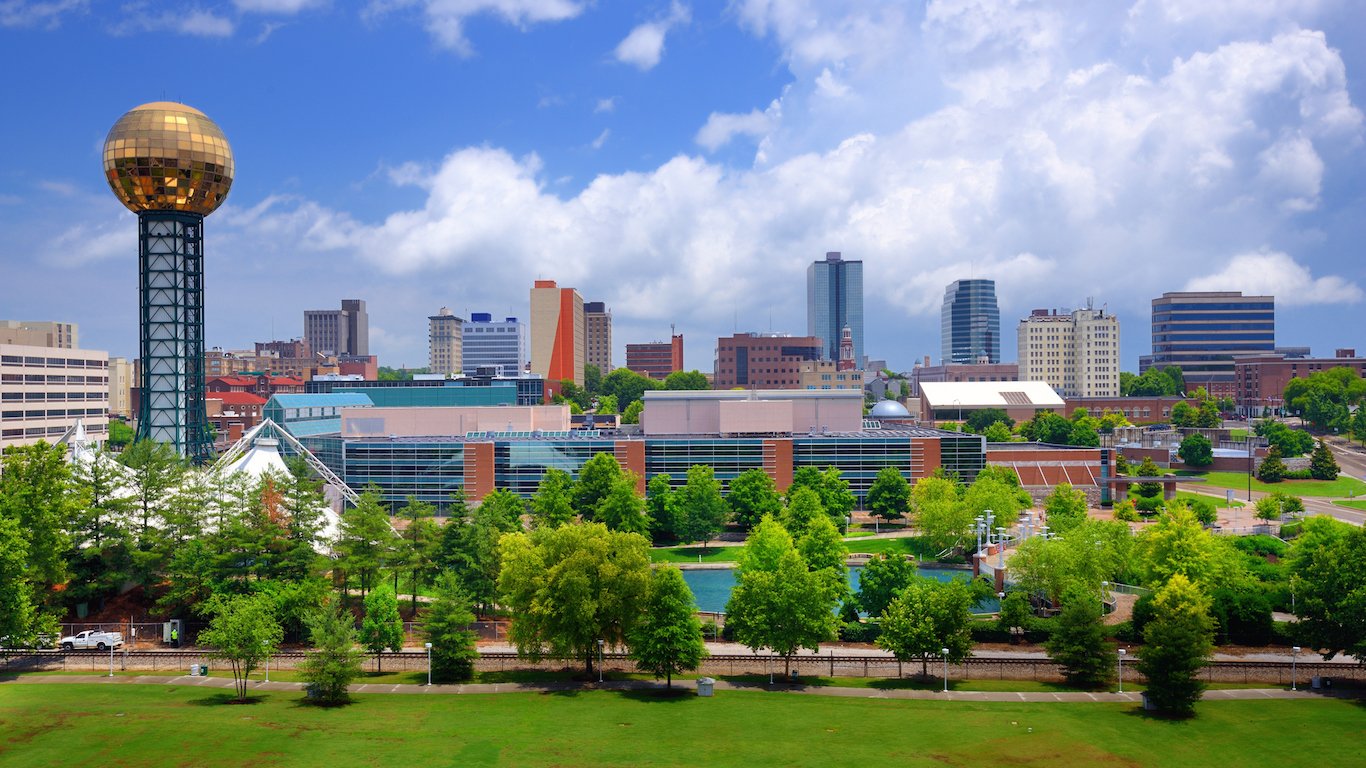
36. Knoxville, Tennessee
> Population: 186,238
> Median home value: $128,000
> Poverty rate: 25.4%
> Pct. with at least a bachelor’s degree: 35.1%
About one in every four Knoxville residents live in poverty, well above the 14% share of Americans and the second highest poverty rate of any large city in the state. Poorer areas often struggle with crime, and in Knoxville, both violent and property crimes are more than twice as common as they are nationwide.
While the city struggles with low incomes and higher crime rates, the home of the University of Tennessee, Knoxville also has some positive attributes common in college towns. For example, 35.1% of residents have a bachelor’s degree, a larger share than is typical nationwide. Additionally, the city has a greater than average concentration of bars and restaurants than the United States as a whole.
[in-text-ad-2]

35. Toledo, Ohio
> Population: 278,512
> Median home value: $79,100
> Poverty rate: 26.3%
> Pct. with at least a bachelor’s degree: 18.7%
Toledo, Ohio, is one of the most dangerous cities in the country. There were 1,192 violent crimes for every 100,000 Toledo residents in 2016, more than three times the statewide violent crime rate and nearly triple the U.S. violent crime rate. A high crime rate can depress home values, and real estate in Toledo ranks among the least expensive in the country. The typical home in the city is worth just $79,100 compared to the value of $205,000 of the typical American home. It is also lower than in all but 13 other U.S. cities
As is the case with nearly every other Midwestern city on this list, Toledo’s population is shrinking. In the last five years, the number of people living in the city fell by 2.6%.

34. Buffalo, New York
> Population: 256,908
> Median home value: $83,500
> Poverty rate: 30.5%
> Pct. with at least a bachelor’s degree: 26.7%
Based on a number of socioeconomic indicators, Buffalo is the worst city to live in in New York state and one of the worst in the country. Buffalo is one of just a handful of cities nationwide where the typical household earns less than $33,000 a year. The low median income is due in part to the high jobless rate. Some 6.3% of Buffalo’s labor force is out of a job, above both the state unemployment rate of 4.8% and the national rate of 4.9%. The jobs market has not improved meaningfully in the western New York city in recent years. Between 2014 and 2016, city employment grew by only 0.1% compared to 3.5% total employment growth nationwide over the same period.
As is the case with most Northeastern cities on this list, Buffalo has lost residents in recent years. In the past half decade, the city’s population count declined by 1.6%, even as the U.S. population expanded by 3.7% over the same period.
[in-text-ad]
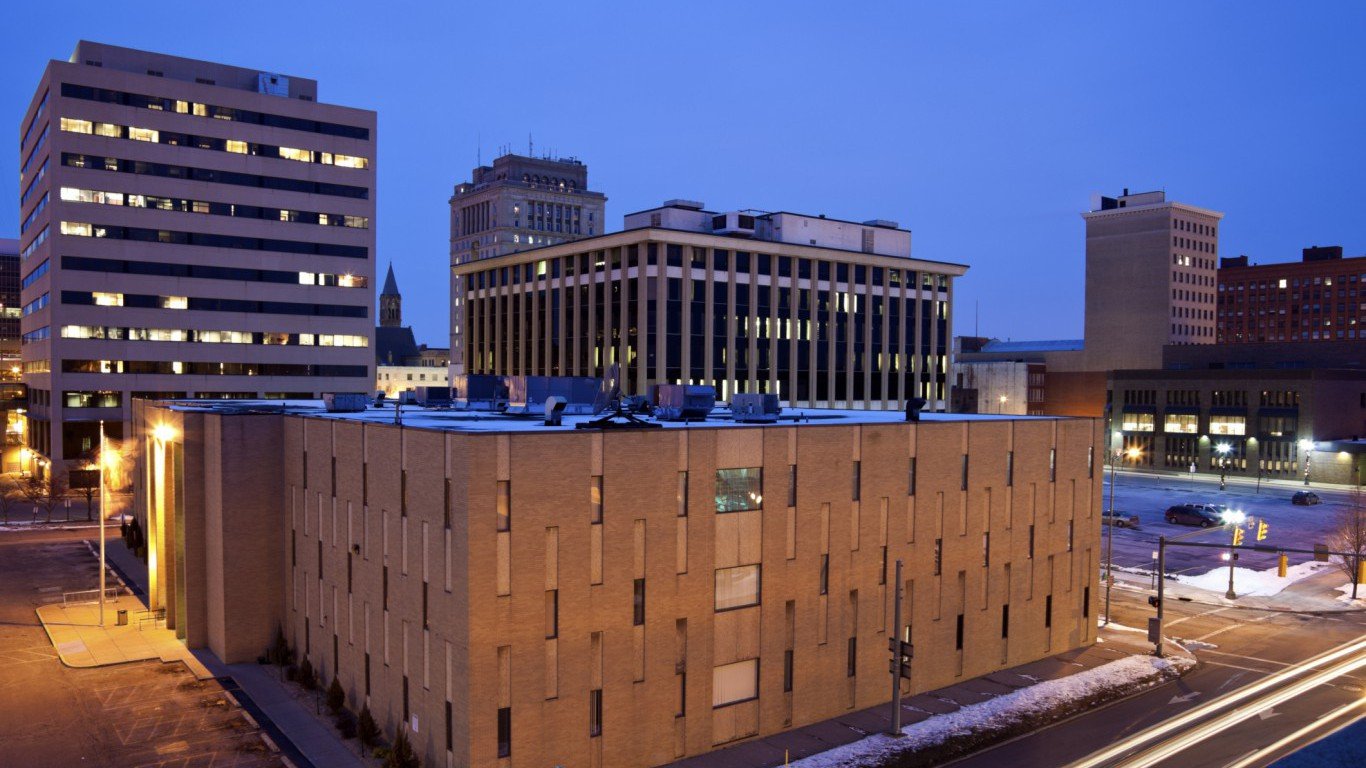
33. Canton, Ohio
> Population: 71,329
> Median home value: $73,400
> Poverty rate: 31.5%
> Pct. with at least a bachelor’s degree: 15.0%
Only 15 cities nationwide have a higher poverty rate than Canton, Ohio, where 31.5% of the population lives below the poverty line. The high poverty rate is likely due in part to the bleak jobs picture. The number of people working in the city fell by 1.3% from 2014 to 2016, and the annual unemployment rate stands at 6.4%. In comparison, employment climbed 3.5% nationwide over the same period and the annual U.S. unemployment rate stands at 4.9%.
Low-income areas often also have low property values, and Canton has some of the cheapest real estate in the country. The typical area home is worth just $73,400 compared to the national median home value of $205,000.
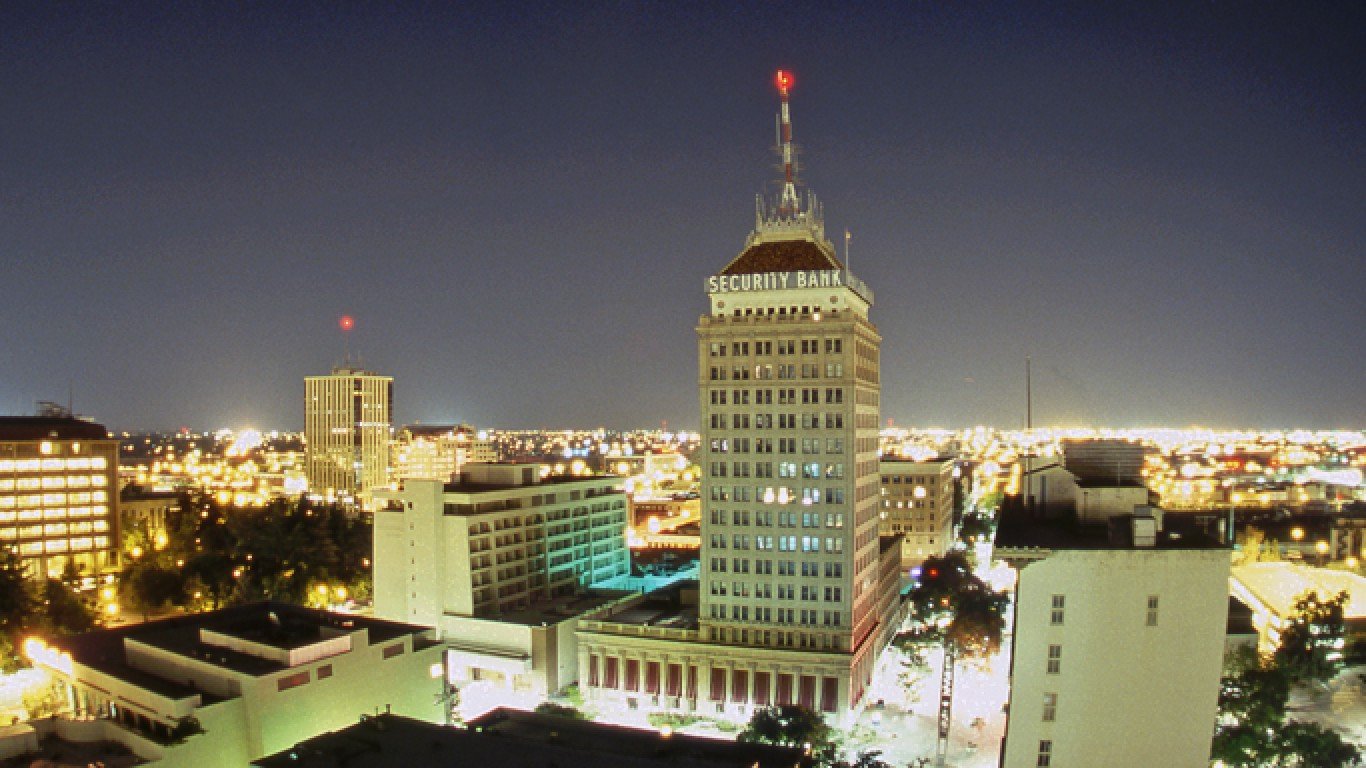
32. Fresno, California
> Population: 522,021
> Median home value: $227,500
> Poverty rate: 28.1%
> Pct. with at least a bachelor’s degree: 21.6%
Fresno is one of half a dozen cities in California to rank among the worst cities to live in nationwide. Like most California cities, Fresno is an expensive place to live. The typical area home is worth $227,500, or about five times the median income of $44,905 in the city. In comparison, the typical American home value of $205,000 is only about 3.6 times the national median income of $57,617.
Fresno is situated in California’s San Joaquin Valley, a region with some of the nation’s worst air quality. In the Fresno area, about 14% of days in a given year have hazardous air quality, compared to only 6% of days nationwide on average.
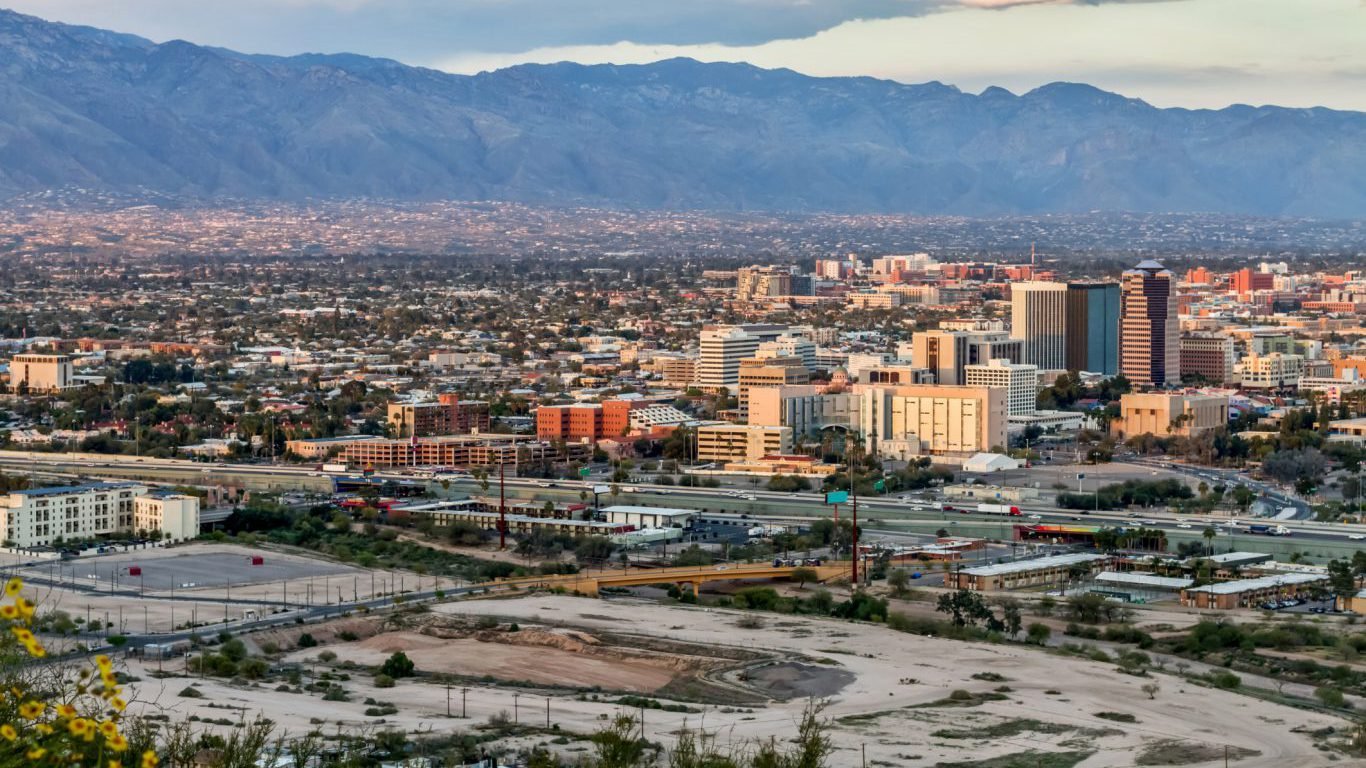
31. Tucson, Arizona
> Population: 530,690
> Median home value: $144,000
> Poverty rate: 24.1%
> Pct. with at least a bachelor’s degree: 26.1%
Tucson is the second most populous city in Arizona and the only city in the state to rank among the worst U.S. cities to live in. The typical Tucson household earns $40,021 a year, only about three-quarters of the median annual household income in Arizona. Additionally, nearly one in every four city residents live in poverty, compared to 14.0% of Americans and 16.4% of people in Arizona. Crime is also relatively common in Tucson. There were 799 violent crimes and 5,891 property crimes in the city in 2016 per 100,000 people, more than double the comparable crime rates on a national scale.
[in-text-ad-2]
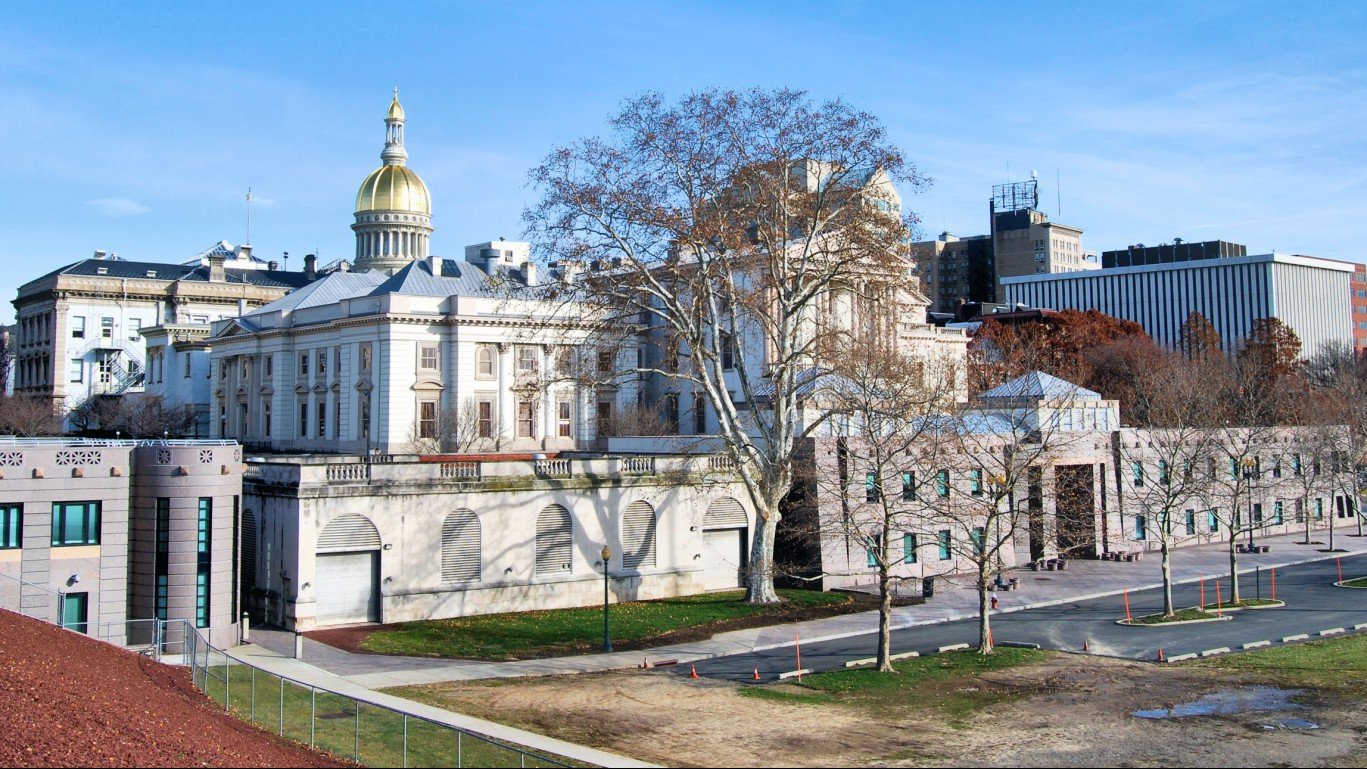
30. Trenton, New Jersey
> Population: 84,065
> Median home value: $86,500
> Poverty rate: 27.8%
> Pct. with at least a bachelor’s degree: 14.8%
In Trenton, one of the poorest cities in the country, more than one in four residents live in poverty, and the typical household earns just $31,592 a year. Low-income Trenton residents live with additional financial stress as goods and services in the county around the New Jersey state capital are about 18% more expensive than they are on average nationwide.
Crime is often more common in poor cities, and Trenton is no exception. There were 1,341 violent crimes for every 100,000 Trenton residents in 2016, a crime rate more than five times that of New Jersey.
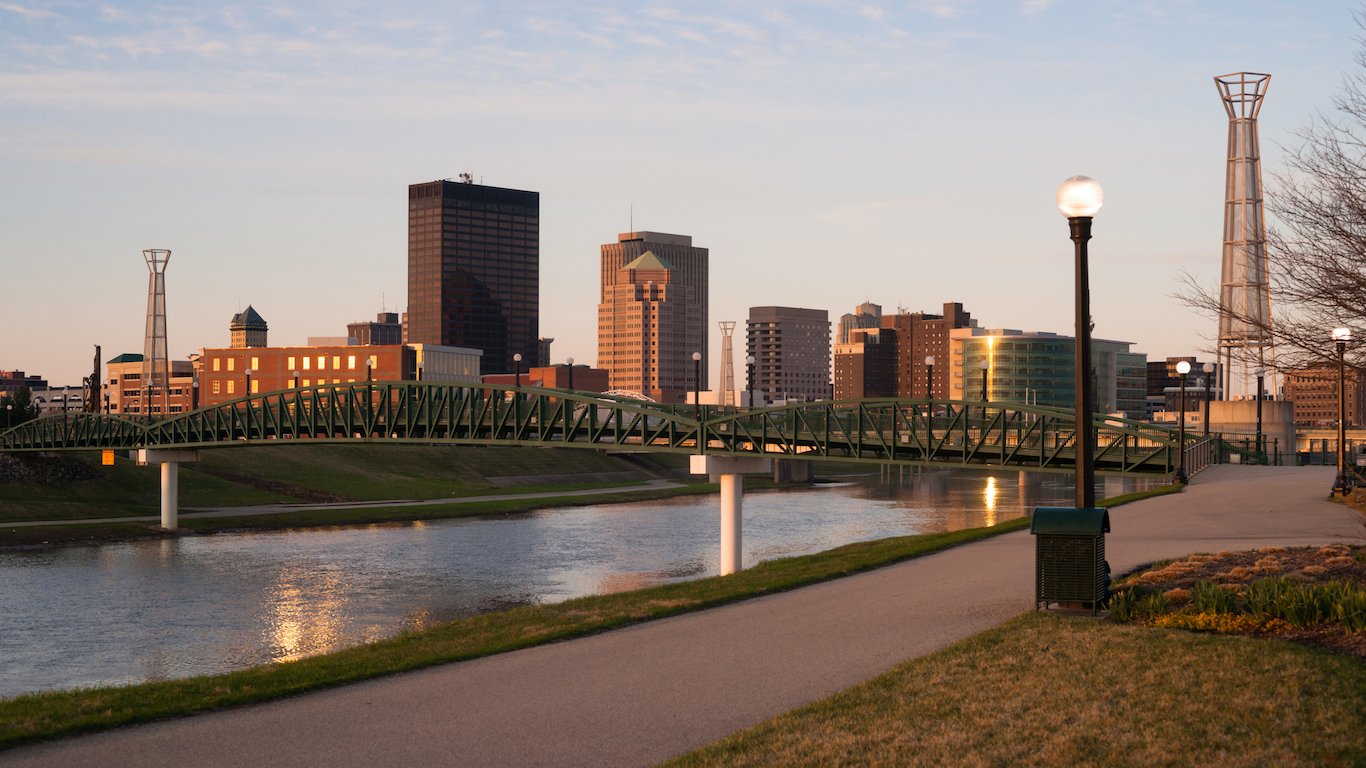
29. Dayton, Ohio
> Population: 140,478
> Median home value: $66,900
> Poverty rate: 32.0%
> Pct. with at least a bachelor’s degree: 16.3%
The median annual household income in Dayton, Ohio, of $28,894 is the sixth lowest among all large U.S. cities. Low-income areas often also have low property values, and Dayton is no exception. The typical home in the city is worth $66,900, also the sixth lowest median home value of any similarly sized city in the United States.
Dayton may be an especially bad place for families with school-aged children. Standardized test scores in Dayton’s public schools are well below the comparable results across Ohio as a whole.

28. Springfield, Massachusetts
> Population: 154,079
> Median home value: $154,300
> Poverty rate: 24.7%
> Pct. with at least a bachelor’s degree: 18.0%
Springfield is the only city in Massachusetts, and one of only three in the broader New England region, to rank among the worst cities to live in. Springfield’s 6.9% unemployment rate is the highest of any Massachusetts city and well above the 4.9% U.S. unemployment rate. The high jobless rate exacerbates financial hardship in the city. About one in every four Springfield residents live below the poverty line, the highest poverty rate of any city in the state.
As is the case with most cities on this list, real estate is relatively inexpensive in Springfield. The typical home is worth $154,300, the lowest median home value of any city in the state and less than half the median home value of $366,900 across Massachusetts.
[in-text-ad]
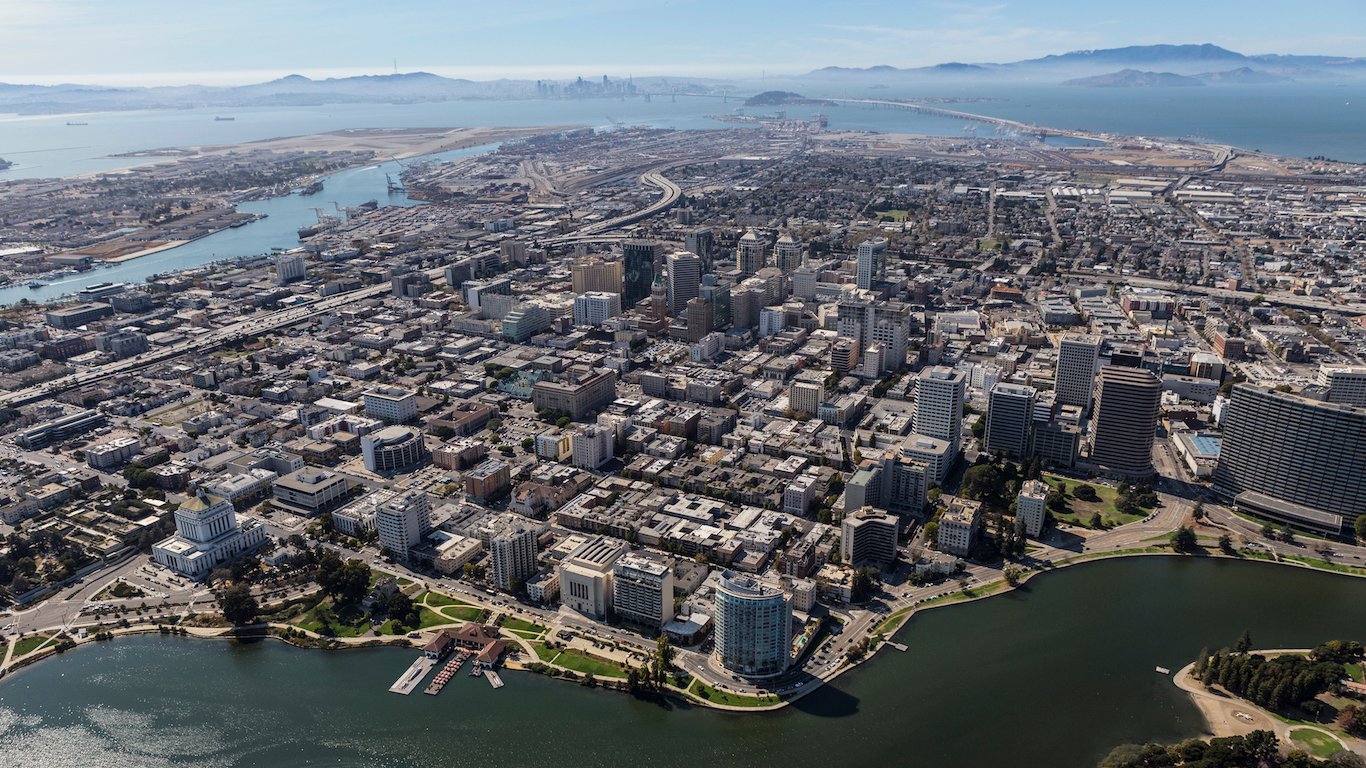
27. Oakland, California
> Population: 419,987
> Median home value: $649,700
> Poverty rate: 18.9%
> Pct. with at least a bachelor’s degree: 41.1%
Oakland’s median household income of $68,060 a year is the highest of any city on this list and higher even than the median income nationwide of $57,617. However, the city’s high incomes are largely offset by a high cost of living, as goods and services are about 27% more expensive in Oakland than they are nationwide, on average. Housing is particularly expensive. The typical home in Oakland is worth nearly $650,000, or about 10 times the city’s median income. Nationwide, the median home value is worth only about 3.6 times the median income.
A high violent crime rate can often drive down property value, but this has not been the case in Oakland. The city has the highest violent crime rate of any California city at 1,443 incidents per 100,000 residents in 2016.
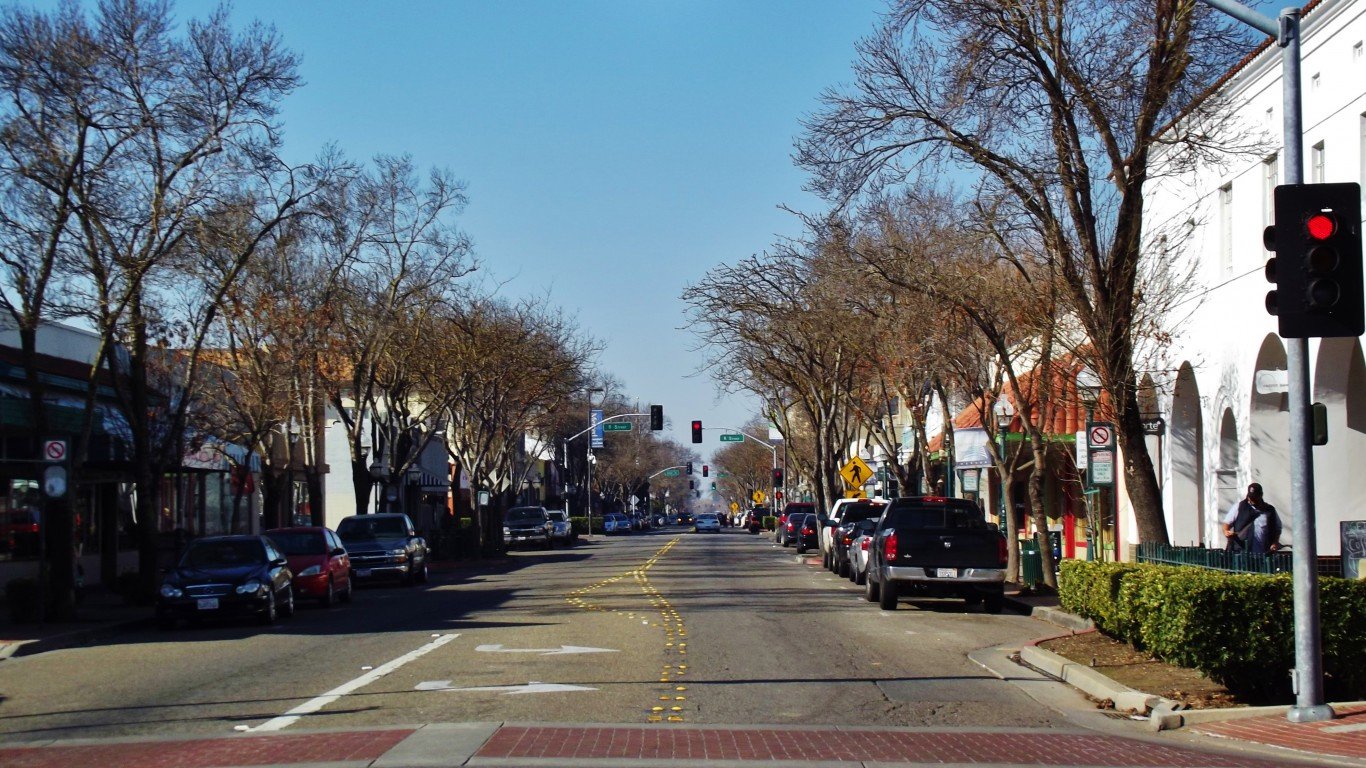
26. Merced, California
> Population: 82,573
> Median home value: $215,400
> Poverty rate: 28.2%
> Pct. with at least a bachelor’s degree: 16.4%
Merced is one of several California cities on this list struggling with high unemployment. About one in every 10 workers in the city are out of a job, the sixth highest unemployment rate of any American city. The high jobless rate may contribute to the city’s high poverty rate. More than one in every four Merced residents live in poverty, well above the 14.0% U.S. poverty rate.
Most American cities have a relatively high concentration of restaurants and bars and places for entertainment, but Merced is an exception. There is a slightly lower than typical concentration of restaurants and eateries in the city, and the concentration of bars is about half the average concentration nationwide.
Thank you for reading! Have some feedback for us?
Contact the 24/7 Wall St. editorial team.
 24/7 Wall St.
24/7 Wall St.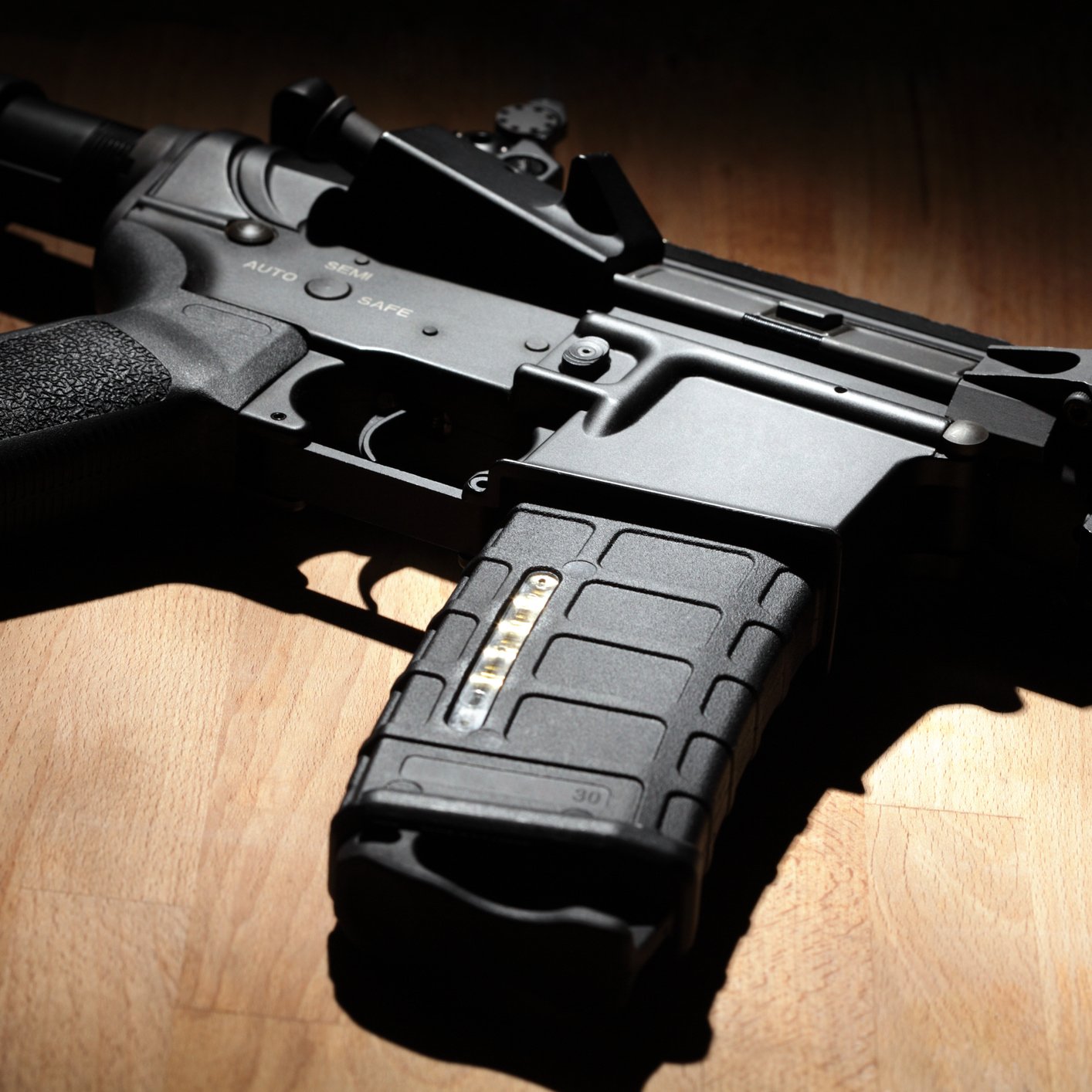 24/7 Wall St.
24/7 Wall St. 24/7 Wall St.
24/7 Wall St. 24/7 Wall St.
24/7 Wall St.
